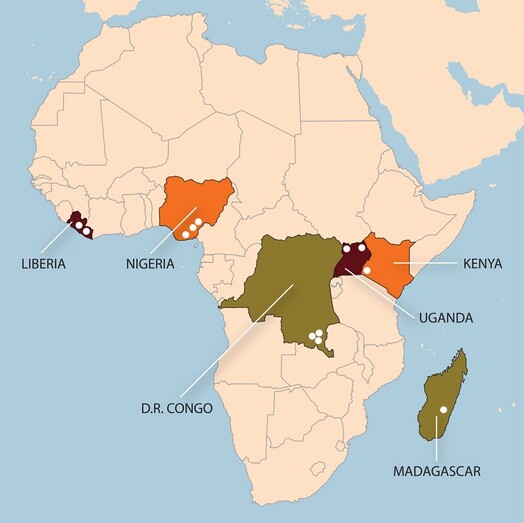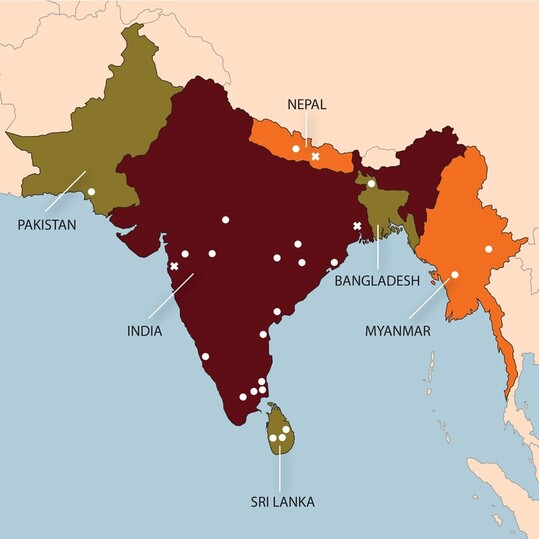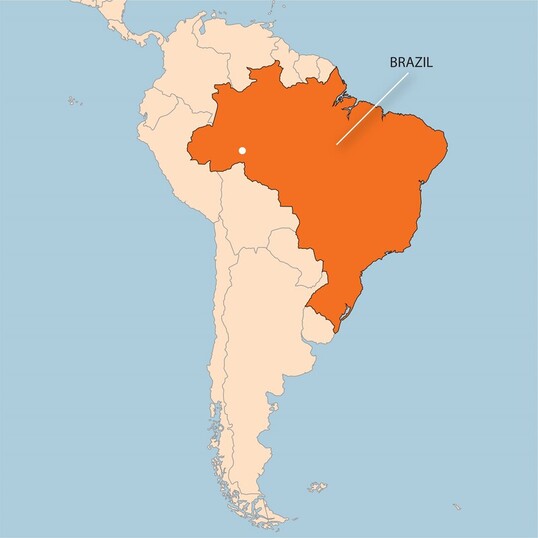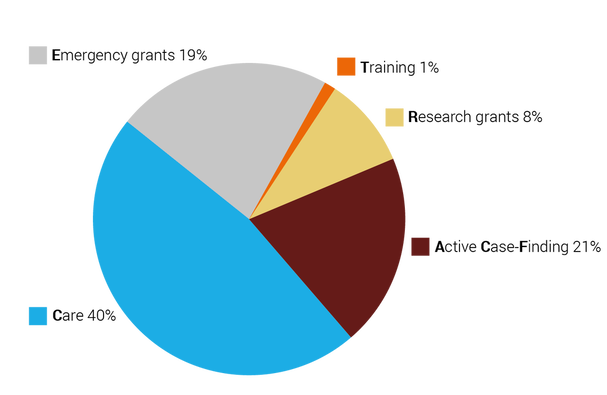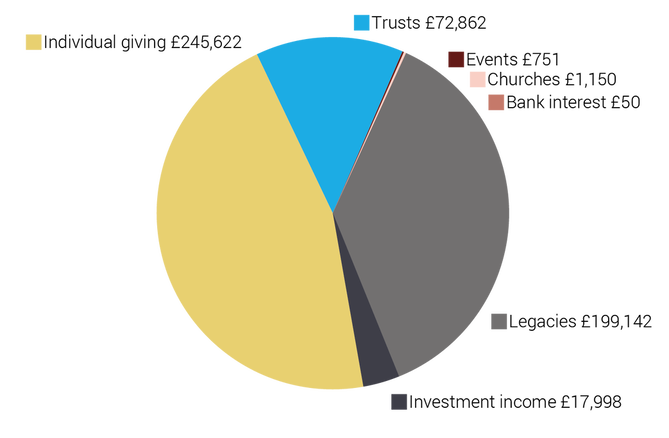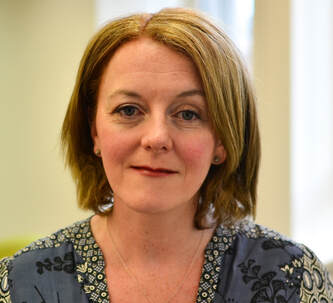PRESS RELEASE
St Francis Leprosy Guild issues its Annual Report 2021
highest income generated since 2015
highest income generated since 2015
London, 6 June 2022: St Francis Leprosy Guild (SFLG) today issued its Annual Report 2021. SFLG was reconstituted as a Charitable Incorporated Organisation (CIO) on 25 March 2020. This annual report is therefore its second as a CIO.
Since a cure was found for leprosy in the 1980s, Non-Government Organisations (NGOs) across the world have a shared vision to end leprosy for good. SFLG has engaged with this approach, responded to opportunities and in particular, has expanded its work beyond the care of leprosy patients, to include research, education, and Active Case-Finding.
The CIO has joined several global boards to strategise, co-ordinate and work together to break the transmission of leprosy and end leprosy for good. These boards include the Global Partnership for Zero Leprosy, the Leprosy Research Initiative, the Neglected Tropical Diseases NGO Network (NNN) and International Anti-leprosy Federation (ILEP.) Through these relationships, SFLG now has direct links with the World Health Organization and the United Nations.
Inspired by the great examples from its past and invigorated by the unique opportunity to end leprosy completely in this generation, SFLG is in a phase of growth. It is passionate about seizing the moment to end leprosy for good. Consequently, it has increased its fundraising activities and is involved in ever more work. It commends its achievements in 2021, thanks its benefactors who made its achievements possible and, invites their future support.
In 2021, SFLG worked in 13 countries worldwide, supporting 40 centres.
The CIO has joined several global boards to strategise, co-ordinate and work together to break the transmission of leprosy and end leprosy for good. These boards include the Global Partnership for Zero Leprosy, the Leprosy Research Initiative, the Neglected Tropical Diseases NGO Network (NNN) and International Anti-leprosy Federation (ILEP.) Through these relationships, SFLG now has direct links with the World Health Organization and the United Nations.
Inspired by the great examples from its past and invigorated by the unique opportunity to end leprosy completely in this generation, SFLG is in a phase of growth. It is passionate about seizing the moment to end leprosy for good. Consequently, it has increased its fundraising activities and is involved in ever more work. It commends its achievements in 2021, thanks its benefactors who made its achievements possible and, invites their future support.
In 2021, SFLG worked in 13 countries worldwide, supporting 40 centres.
SFLG's objectives and aims (page 9)
SFLG's objectives and aims are summarised as follows:
SFLG's objectives and aims are summarised as follows:
- funding organisations throughout the world, that give relief and assistance to persons with leprosy or disabled because of leprosy, their families, and dependents
- funding activity towards prevention and control of the disease of leprosy, including relevant investigations and research of the causes, treatment, and prevention of this disease and
- carrying out or funding the professional education of those engaged in the prevention, diagnosis, and treatment of leprosy.
Significant activities (page 9)
In 2021, SFLG crystallised its operating strategy under the TRACE acronym:
Training Training professionals worldwide to identify the earliest signs of leprosy, so that the disease can be diagnosed and treated before disability and disfigurement occurs. Read about Kedouse Yousef's training grant
Research Running or supporting research programmes to innovate in breaking the transmission of leprosy or improving the care of people affected by it. Read about research into multi-spectral screening
Active Case-Finding Operating programmes which screen endemic communities for the early identification and treatment of people with leprosy. Read about our pioneering work in Active Case-Finding
Care Providing relief, assistance and rehabilitation for people diagnosed with leprosy. Read about our centres and case studies
Emergency relief Ensuring our communities can continue to offer their services in unforeseen circumstances.
In 2021, SFLG crystallised its operating strategy under the TRACE acronym:
Training Training professionals worldwide to identify the earliest signs of leprosy, so that the disease can be diagnosed and treated before disability and disfigurement occurs. Read about Kedouse Yousef's training grant
Research Running or supporting research programmes to innovate in breaking the transmission of leprosy or improving the care of people affected by it. Read about research into multi-spectral screening
Active Case-Finding Operating programmes which screen endemic communities for the early identification and treatment of people with leprosy. Read about our pioneering work in Active Case-Finding
Care Providing relief, assistance and rehabilitation for people diagnosed with leprosy. Read about our centres and case studies
Emergency relief Ensuring our communities can continue to offer their services in unforeseen circumstances.
Partner due diligence SFLG carried out due diligence on any potential partners to ensure:
SFLG also adopts a risk-rated approach to due diligence. Risk factors include:
The results of any due diligence do not last indefinitely. In cases where beneficiaries are supported for a significant period, additional due diligence is undertaken if there is a change of circumstances that might impact the partner or in any case, every year.
Campaigning In 2021, SFLG campaigned on several issues affecting people with leprosy. These issues included:
In total, over 20 articles were written in response to SFLG campaigns.
Fundraising and performance (page 14)
- the identity of the beneficiary
- that funds are applied in accordance with SFLG’s charitable purposes
- that funds are not knowingly used for money laundering, financing terrorism or bribery.
SFLG also adopts a risk-rated approach to due diligence. Risk factors include:
- the funding contributed
- the country of residence of the recipient
- the geographical location in which the grant will be applied
- the nature of the relationship between the charity and the applicant.
The results of any due diligence do not last indefinitely. In cases where beneficiaries are supported for a significant period, additional due diligence is undertaken if there is a change of circumstances that might impact the partner or in any case, every year.
Campaigning In 2021, SFLG campaigned on several issues affecting people with leprosy. These issues included:
- ensuring people with leprosy had equitable access to the Covid-19 vaccine when it was rolled out. SFLG raised awareness of why people with leprosy might be especially vulnerable to Covid-19 and championed their right to receive vaccines in parity to their peers
- advising that countries were cautious about declaring ‘elimination’ and ensuring that enough focus and resources remained in place to drive leprosy across the final mile.
In total, over 20 articles were written in response to SFLG campaigns.
Fundraising and performance (page 14)
I am delighted to report that in 2021, SFLG generated £537,575 income, its highest since 2015. In addition, our fundraising has become more diversified. In 2020, legacies comprised 65 per cent of our income - making us very reliant on a single unpredictable source. In 2021, legacies made up 37 percent of the total. |
Marketing In 2021, SFLG’s individual giving increased to £245,622 including Gift Aid. The main means of introducing new donors and raising funds is through inserts in various press titles. SFLG communicates twice a year with existing opted-in donors. In May, SFLG sends a copy of its Annual Review describing the previous year’s activities and in October it sends a further newsletter informing donors of how their donations are being used.
SFLG is registered with the Fundraising Regulator and complies with its practices. No complaints were received about any aspect of fundraising in the reporting period. SFLG is compliant with General Data Protection Regulation in all its activities and no data are sold to other organisations.
SFLG made considerable improvements to its website, including the implementation of a new donations journey using Enthuse technology, profiling SFLG’s centres and case studies of people it has helped, and regularly updated news. At Christmas, SFLG ran its first ever email campaign to donors. The campaign included an email, an animation, a display of Christmas celebrations taking place at its centres and a leprosy campaign. SFLG maintained social media profiles on Facebook, Twitter, and LinkedIn. It improved its visibility with Google AdWords. In total, SFLG received £18,772 donations online (eight per cent).
SFLG is registered with the Fundraising Regulator and complies with its practices. No complaints were received about any aspect of fundraising in the reporting period. SFLG is compliant with General Data Protection Regulation in all its activities and no data are sold to other organisations.
SFLG made considerable improvements to its website, including the implementation of a new donations journey using Enthuse technology, profiling SFLG’s centres and case studies of people it has helped, and regularly updated news. At Christmas, SFLG ran its first ever email campaign to donors. The campaign included an email, an animation, a display of Christmas celebrations taking place at its centres and a leprosy campaign. SFLG maintained social media profiles on Facebook, Twitter, and LinkedIn. It improved its visibility with Google AdWords. In total, SFLG received £18,772 donations online (eight per cent).
We are deeply touched when SFLG is named in a will. We have developed new means to remember those who have acted in this way. Their details are captured in a Book of Remembrance and we pray for them regularly. In addition, we have developed an online Garden of Remembrance.
CEO, Clare McIntosh
Legacies In 2021, SFLG received £199,142 in legacies (in comparison with £164,821 for 2020). The level of legacies in 2021 was slightly above the five-year average.
Talks SFLG has given talks on leprosy to build awareness and generate income. Talks were given to universities, churches, Rotary and Catena Clubs. This activity resulted in £751 being raised.
The Annual Benefactors Mass celebrating SFLG’s 125th anniversary was held for its Catholic donors at Southwark Cathedral on 30 October. It was presided over by Archbishop John Wilson and concelebrated with 12 priests. The Mass was livestreamed to SFLG’s centres. The feedback on those who attended was exceptional. A reception and assembly followed the Mass. It was a great opportunity for SFLG to meet its supporters and understand how they became aware of St Francis Leprosy Guild, what attracted them to it, and to receive their feedback on what it does today. £900 was raised from contributions at the Mass.
Trusts SFLG received a £30,000 grant from the Sir Harold Hood Charitable Trust and £38,000 from the Sir Pierce Lacy Trust, as well as several smaller donations. SFLG thanks both trusts for their continued support.
Volunteers SFLG is privileged to have established an exceptionally high-quality Board of Trustees, many of whom are leaders in their fields. The trustees gave extensively of their time, and in addition, SFLG had the benefit of an accountancy intern over the summer. The total value of the volunteer time has been estimated at £200,000 per year.
Staff SFLG continues to operate on a very small staff. The costs of staff and contractors have increased from 2020-2021 reflecting its growing size, the increasing complexity of its activities, and the shift of finance responsibilities from volunteers to a paid staff.
During the year, SFLG’s only employees were a Chief Executive Officer, a Finance Manager, and an Administrator. SFLG worked with a contractor, Katharine Jones of KVHcom.com. who helped SFLG raise its profile online and through the media. SFLG believes it is seeing the benefit of her work in the doubling of its individual giving. SFLG also brought in some additional help in processing donations during the lockdown periods. SFLG decided that, in the long term, processing donations could be achieved more efficiently and consistently by a third party and has now outsourced these activities to Telebank and expects with a saving of approximately £25,000 a year.
The Annual Benefactors Mass celebrating SFLG’s 125th anniversary was held for its Catholic donors at Southwark Cathedral on 30 October. It was presided over by Archbishop John Wilson and concelebrated with 12 priests. The Mass was livestreamed to SFLG’s centres. The feedback on those who attended was exceptional. A reception and assembly followed the Mass. It was a great opportunity for SFLG to meet its supporters and understand how they became aware of St Francis Leprosy Guild, what attracted them to it, and to receive their feedback on what it does today. £900 was raised from contributions at the Mass.
Trusts SFLG received a £30,000 grant from the Sir Harold Hood Charitable Trust and £38,000 from the Sir Pierce Lacy Trust, as well as several smaller donations. SFLG thanks both trusts for their continued support.
Volunteers SFLG is privileged to have established an exceptionally high-quality Board of Trustees, many of whom are leaders in their fields. The trustees gave extensively of their time, and in addition, SFLG had the benefit of an accountancy intern over the summer. The total value of the volunteer time has been estimated at £200,000 per year.
Staff SFLG continues to operate on a very small staff. The costs of staff and contractors have increased from 2020-2021 reflecting its growing size, the increasing complexity of its activities, and the shift of finance responsibilities from volunteers to a paid staff.
During the year, SFLG’s only employees were a Chief Executive Officer, a Finance Manager, and an Administrator. SFLG worked with a contractor, Katharine Jones of KVHcom.com. who helped SFLG raise its profile online and through the media. SFLG believes it is seeing the benefit of her work in the doubling of its individual giving. SFLG also brought in some additional help in processing donations during the lockdown periods. SFLG decided that, in the long term, processing donations could be achieved more efficiently and consistently by a third party and has now outsourced these activities to Telebank and expects with a saving of approximately £25,000 a year.
Operating costs SFLG maintains close attention to the control, and where possible, the reduction, of its annual operating costs. It took the following actions to reduce operating costs in 2021:
Safeguarding SFLG's employees do not have direct contact with leprosy sufferers, vulnerable adults, or children, but the prime purpose of its partner organisations is the daily care of such persons. The trustees require that all those conducting projects on SFLG’s behalf must comply with SFLG's Safeguarding Policy and Code of Conduct. All SFLG's partner organisations in 2021 confirmed in writing that they were in full compliance with both documents. This requirement will continue to be an absolute necessity for any future potential partner organisations.
Accounting practice These accounts have been prepared on an accrual basis.
Reserves Policy Today SFLG holds unrestricted reserves of £1.3 million. The trustees have reviewed the activities and commitments of the CIO and determined that, to ensure continuity of activities and honour contractual liabilities, a level of free reserves should be maintained of around £720,000.
The trustees have approved a rolling five-year strategic plan and confirmed that the following designations, all to be used in 2022, are necessary to ensure its delivery.
Active Case-Finding projects: £240,000
Training: £10,000
Emergency projects: £30,000
Capital funding: £15,000
Fundraising: £143,000
Total: £438,000
The trustees reviewed the small remaining balance of Unrestricted Reserves (£147,000) and concluded it is a reasonable cushion of contingency for the further implementation of the Strategic Plan considering the volatility of the external economic environment.
Investment policy and objectives The trustees are eager to generate a level of returns from its reserves without taking on unacceptable risk. Its approach is to accept a level of medium risk, with a balance sought between realising a target income and achieving capital growth. Investments are divided among equities, bonds, cash, and alternatives. The portfolio is externally managed by investment managers who are regulated by the Financial Conduct Authority. Updates on the value of the portfolio are provided to SFLG quarterly. Once a year it discusses the performance of the investments with its investment manager, the prevailing and anticipated economic conditions, a forecast of future trends and it looks at future cash requirements to be funded by these investments. The trustees review the level of risk annually. In the implementation of this policy, the trustees follow the Charity Commission guidance for the investment of charitable funds.
Risk assessment The trustees have assessed the major risks to which the CIO is exposed, those related to the governance, operations, finances of SFLG as well as those relating to the external economic environment and the regulatory framework in which SFLG operates. The trustees review these risks on a regular basis and are satisfied that the systems in place will mitigate exposure to major risks from within SFLG.
- moved to a smaller office, but still located at 73 St Charles Square, with a reduced annual rent of £6,000, compared to £13,500 per year in previous years
- agreed a one-off dilapidation bill of £5,000 to exit the previous office, saving £9,000 a year
- moved the donation processing to Telebank, saving £25,000 a year
- received a bursary from The Foundation for Social Improvement, which provided approximately 20 training sessions for SFLG as part of its International Development Charities Programme, a saving that equated to £4,000
- removed the landline and replaced it with a MiFi dongle, saving £1,700 a year.
Safeguarding SFLG's employees do not have direct contact with leprosy sufferers, vulnerable adults, or children, but the prime purpose of its partner organisations is the daily care of such persons. The trustees require that all those conducting projects on SFLG’s behalf must comply with SFLG's Safeguarding Policy and Code of Conduct. All SFLG's partner organisations in 2021 confirmed in writing that they were in full compliance with both documents. This requirement will continue to be an absolute necessity for any future potential partner organisations.
Accounting practice These accounts have been prepared on an accrual basis.
Reserves Policy Today SFLG holds unrestricted reserves of £1.3 million. The trustees have reviewed the activities and commitments of the CIO and determined that, to ensure continuity of activities and honour contractual liabilities, a level of free reserves should be maintained of around £720,000.
The trustees have approved a rolling five-year strategic plan and confirmed that the following designations, all to be used in 2022, are necessary to ensure its delivery.
Active Case-Finding projects: £240,000
Training: £10,000
Emergency projects: £30,000
Capital funding: £15,000
Fundraising: £143,000
Total: £438,000
The trustees reviewed the small remaining balance of Unrestricted Reserves (£147,000) and concluded it is a reasonable cushion of contingency for the further implementation of the Strategic Plan considering the volatility of the external economic environment.
Investment policy and objectives The trustees are eager to generate a level of returns from its reserves without taking on unacceptable risk. Its approach is to accept a level of medium risk, with a balance sought between realising a target income and achieving capital growth. Investments are divided among equities, bonds, cash, and alternatives. The portfolio is externally managed by investment managers who are regulated by the Financial Conduct Authority. Updates on the value of the portfolio are provided to SFLG quarterly. Once a year it discusses the performance of the investments with its investment manager, the prevailing and anticipated economic conditions, a forecast of future trends and it looks at future cash requirements to be funded by these investments. The trustees review the level of risk annually. In the implementation of this policy, the trustees follow the Charity Commission guidance for the investment of charitable funds.
Risk assessment The trustees have assessed the major risks to which the CIO is exposed, those related to the governance, operations, finances of SFLG as well as those relating to the external economic environment and the regulatory framework in which SFLG operates. The trustees review these risks on a regular basis and are satisfied that the systems in place will mitigate exposure to major risks from within SFLG.
Structure, governance and management (page 18)
SFLG is controlled by its governing document, a deed of trust and constitutes an incorporated charity.
Charity constitution SFLG is a Charitable Incorporated Organisation that was established on 25 March 2020.
Charitable structure SFLG changed its charitable status from an Unincorporated Association to a Charitable Incorporated (Foundation) Organisation (CIO) on 25 March 2020. In consequence of the change of Charitable status the 2019 Annual Report and Accounts of the former charity were not required by the Charity Commission but are publicly available on SFLG’s website.
Appointment of trustees Under SFLG’s constitution, up to 12 trustees may be appointed for up to three terms of three years but may not be reappointed for a fourth term until after an interval of at least one year. Trustees are appointed based on suitable qualifications and experience. They are briefed on the activities of SFLG and their responsibilities as trustees by the existing trustees. They manage the affairs of the CIO and exercise individually and jointly the powers set out in the Constitution. The Provincial or Custos of the Order of Friars Minors is Spiritual Director and a trustee ex officio. The Bishops Conference of England and Wales (CBCEW) nominates a trustee to represent them.
In 2021, three trustees stood down from the Board each having given many years of service. SFLG is very grateful for their long and valuable contributions. Liam Allmark joined the Board as the nomination of the Bishops Conference, and SFLG welcomed Clare Barton, an experienced lawyer who serves several charities on a voluntary basis. A trustee’s skills audit is up to date.
All trustees gave their time freely and no remuneration was paid to trustees during the year. Details of trustee expenses and related transactions are disclosed in the notes to the accounts. Trustees are required to disclose all relevant interests at each meeting.
Trustees' responsibility statement The trustees are responsible for preparing the Report of the Trustees and the financial statements in accordance with applicable law and United Kingdom Accounting Standards (United Kingdom Generally Accepted Accounting Practice) including Financial Reporting Standard 102 The Financial Reporting Standard applicable in the UK and Republic of Ireland.
The law applicable to charities in England and Wales, the Charities Act 2011, Charity (Accounts and Reports) Regulations 2008 and the provisions of the trust deed, requires the trustees to prepare financial statements for each financial year which give a true and fair view of the state of affairs of the charity and of the incoming resources and application of resources, including the income and expenditure, of the charity for that period. In preparing those financial statements, the trustees are required to:
The trustees are responsible for keeping proper accounting records which disclose with reasonable accuracy at any time the financial position of the charity and to enable them to ensure that the financial statements comply with the Charities Act 2011, the Charity (Accounts and Reports) Regulations 2008 and the provisions of the trust deed. They are also responsible for safeguarding the assets of the charity and hence for taking reasonable steps for the prevention and detection of fraud and other irregularities.
The trustees are responsible for the maintenance and integrity of the charity and financial information included on the charity's website. Legislation in the United Kingdom governing the preparation and dissemination of financial statements may differ from legislation in other jurisdictions.
Chair, Michael Forbes Smith KHS
20 May 2022
SFLG is controlled by its governing document, a deed of trust and constitutes an incorporated charity.
Charity constitution SFLG is a Charitable Incorporated Organisation that was established on 25 March 2020.
Charitable structure SFLG changed its charitable status from an Unincorporated Association to a Charitable Incorporated (Foundation) Organisation (CIO) on 25 March 2020. In consequence of the change of Charitable status the 2019 Annual Report and Accounts of the former charity were not required by the Charity Commission but are publicly available on SFLG’s website.
Appointment of trustees Under SFLG’s constitution, up to 12 trustees may be appointed for up to three terms of three years but may not be reappointed for a fourth term until after an interval of at least one year. Trustees are appointed based on suitable qualifications and experience. They are briefed on the activities of SFLG and their responsibilities as trustees by the existing trustees. They manage the affairs of the CIO and exercise individually and jointly the powers set out in the Constitution. The Provincial or Custos of the Order of Friars Minors is Spiritual Director and a trustee ex officio. The Bishops Conference of England and Wales (CBCEW) nominates a trustee to represent them.
In 2021, three trustees stood down from the Board each having given many years of service. SFLG is very grateful for their long and valuable contributions. Liam Allmark joined the Board as the nomination of the Bishops Conference, and SFLG welcomed Clare Barton, an experienced lawyer who serves several charities on a voluntary basis. A trustee’s skills audit is up to date.
All trustees gave their time freely and no remuneration was paid to trustees during the year. Details of trustee expenses and related transactions are disclosed in the notes to the accounts. Trustees are required to disclose all relevant interests at each meeting.
Trustees' responsibility statement The trustees are responsible for preparing the Report of the Trustees and the financial statements in accordance with applicable law and United Kingdom Accounting Standards (United Kingdom Generally Accepted Accounting Practice) including Financial Reporting Standard 102 The Financial Reporting Standard applicable in the UK and Republic of Ireland.
The law applicable to charities in England and Wales, the Charities Act 2011, Charity (Accounts and Reports) Regulations 2008 and the provisions of the trust deed, requires the trustees to prepare financial statements for each financial year which give a true and fair view of the state of affairs of the charity and of the incoming resources and application of resources, including the income and expenditure, of the charity for that period. In preparing those financial statements, the trustees are required to:
- select suitable accounting policies and then apply them consistently
- observe the methods and principles in the Charity SORP
- make judgements and estimates that are reasonable and prudent
- state whether applicable accounting standards have been followed, subject to any material departures disclosed and explained in the financial statements
- prepare the financial statements on the going concern basis unless it is inappropriate to presume that the charity will continue in business.
The trustees are responsible for keeping proper accounting records which disclose with reasonable accuracy at any time the financial position of the charity and to enable them to ensure that the financial statements comply with the Charities Act 2011, the Charity (Accounts and Reports) Regulations 2008 and the provisions of the trust deed. They are also responsible for safeguarding the assets of the charity and hence for taking reasonable steps for the prevention and detection of fraud and other irregularities.
The trustees are responsible for the maintenance and integrity of the charity and financial information included on the charity's website. Legislation in the United Kingdom governing the preparation and dissemination of financial statements may differ from legislation in other jurisdictions.
Chair, Michael Forbes Smith KHS
20 May 2022
Inspired by the great examples from our past and invigorated by the unique opportunity we have to end leprosy completely in this generation, SFLG is in a phase of growth. We are passionate about seizing the moment to end leprosy for good. We commend our achievements in 2021, thank our benefactors and supporters who made our achievements possible and we invite their future support.
Chair, Michael Forbes Smith KHS
Independent examiner's report (page 20)
Financial statements (page 21)
St Francis Leprosy Guild (page 7)
SFLG has cared for people with leprosy for over 125 years. It was founded on 23 October 1895 by Kate Marsden, a nurse from North London who had been inspired by reports of the missionary, Father (now Saint) Damien of Molokai. For most of its history, the focus has been on providing medical and pastoral care for people diagnosed with leprosy. Leprosy has been greatly feared throughout generations. Societies have forcefully segregated people with leprosy, and few have wanted to work with those affected. Therefore, in history, it has often been the Roman Catholic Orders that have chosen to take on this task. This care remains a substantial element of our work.
About leprosy (page 6)
Leprosy is a complex, chronic, transmissible neglected tropical disease caused by the Mycobacterium leprae bacterium. It affects the skin, upper respiratory tract and peripheral nerves in the hands, feet, and eyes. Leprosy can affect anyone, at any age, but it is linked to poverty, malnutrition, and genetic susceptibility. It remains a health problem in low and middle-income countries worldwide with at least 200,000 diagnoses a year. This means that globally, every two minutes a person is diagnosed with leprosy. Over 50 diagnoses each day are children.
Leprosy may incubate for up to 20 years before it presents with any signs. In its earliest stages it can present as a small patch of discoloured skin, or an area in which there is little feeling. People experiencing this lack of sensation may not seek help for a long period of time, as they feel no pain or discomfort. If they suspect it could be leprosy, very often they will be afraid to seek treatment because of the stigma and its consequences. Since these communities tend to be remote and impoverished, it can be difficult for people to reach medical centres, and they may not be able to pay for medical care.
Leprosy is a progressive disease, and people lose feeling in affected areas which can lead to permanent damage, lifelong ulcers and loss of fingers and toes. As such, leprosy is the biggest global cause of acquired disability. While untreated, the person affected may unwittingly transmit the disease throughout the community and to family and friends.
Because leprosy is known to be transmissible, predominantly by airborne droplets, it is greatly feared, even though it is highly unlikely that it can be passed on by direct contact. People with visible signs of leprosy are likely to suffer from intense stigma and discrimination that can destroy their livelihoods and entire lives. Across the world, 120 laws still exist that discriminate against people with leprosy.
Since the 1990s, it has been possible to cure leprosy with Multidrug Therapy (MDT). Shortly after receiving treatment, symptoms will stop developing and a person affected by leprosy will no longer be infectious. The development of a cure has significantly reduced the new diagnoses of leprosy from more than five million a year in the 1980s, to 200,000 a year, today. However, since the millennium, the downwards trend for leprosy seems to have stalled and needs renewed focus. We believe we are on the ‘final mile’ for leprosy and, with a global, focused effort, we might be able to end leprosy completely within a generation.
An end to leprosy, will not help those living with historic complications. Five to six million people are still living with disabilities long after their leprosy has been cured. Many of these are living in deeply impoverished conditions, completely cut off from society with charities like SFLG taking care of their needs.
127 countries worldwide reported leprosy to the World Health Organization (WHO) during 2021. The WHO has identified 23 Global Priority countries for leprosy, where over 95 per cent of people detected with leprosy are found.
The Covid-19 pandemic has caused significant setbacks in the goal to end leprosy. For the period of the pandemic, resources across the world have been diverted away from leprosy towards Covid-19. This means that fewer people have been diagnosed in this period and live with worsening symptoms, continuing to be contagious. Some of those diagnosed have not completed the full course of treatment, and others have not received care for their wounds. As vaccinations roll out and the pandemic becomes less of a global threat, it is extremely important that lost ground is recovered and that, those living with undiagnosed or not fully cured leprosy are found.
SFLG has cared for people with leprosy for over 125 years. It was founded on 23 October 1895 by Kate Marsden, a nurse from North London who had been inspired by reports of the missionary, Father (now Saint) Damien of Molokai. For most of its history, the focus has been on providing medical and pastoral care for people diagnosed with leprosy. Leprosy has been greatly feared throughout generations. Societies have forcefully segregated people with leprosy, and few have wanted to work with those affected. Therefore, in history, it has often been the Roman Catholic Orders that have chosen to take on this task. This care remains a substantial element of our work.
About leprosy (page 6)
Leprosy is a complex, chronic, transmissible neglected tropical disease caused by the Mycobacterium leprae bacterium. It affects the skin, upper respiratory tract and peripheral nerves in the hands, feet, and eyes. Leprosy can affect anyone, at any age, but it is linked to poverty, malnutrition, and genetic susceptibility. It remains a health problem in low and middle-income countries worldwide with at least 200,000 diagnoses a year. This means that globally, every two minutes a person is diagnosed with leprosy. Over 50 diagnoses each day are children.
Leprosy may incubate for up to 20 years before it presents with any signs. In its earliest stages it can present as a small patch of discoloured skin, or an area in which there is little feeling. People experiencing this lack of sensation may not seek help for a long period of time, as they feel no pain or discomfort. If they suspect it could be leprosy, very often they will be afraid to seek treatment because of the stigma and its consequences. Since these communities tend to be remote and impoverished, it can be difficult for people to reach medical centres, and they may not be able to pay for medical care.
Leprosy is a progressive disease, and people lose feeling in affected areas which can lead to permanent damage, lifelong ulcers and loss of fingers and toes. As such, leprosy is the biggest global cause of acquired disability. While untreated, the person affected may unwittingly transmit the disease throughout the community and to family and friends.
Because leprosy is known to be transmissible, predominantly by airborne droplets, it is greatly feared, even though it is highly unlikely that it can be passed on by direct contact. People with visible signs of leprosy are likely to suffer from intense stigma and discrimination that can destroy their livelihoods and entire lives. Across the world, 120 laws still exist that discriminate against people with leprosy.
Since the 1990s, it has been possible to cure leprosy with Multidrug Therapy (MDT). Shortly after receiving treatment, symptoms will stop developing and a person affected by leprosy will no longer be infectious. The development of a cure has significantly reduced the new diagnoses of leprosy from more than five million a year in the 1980s, to 200,000 a year, today. However, since the millennium, the downwards trend for leprosy seems to have stalled and needs renewed focus. We believe we are on the ‘final mile’ for leprosy and, with a global, focused effort, we might be able to end leprosy completely within a generation.
An end to leprosy, will not help those living with historic complications. Five to six million people are still living with disabilities long after their leprosy has been cured. Many of these are living in deeply impoverished conditions, completely cut off from society with charities like SFLG taking care of their needs.
127 countries worldwide reported leprosy to the World Health Organization (WHO) during 2021. The WHO has identified 23 Global Priority countries for leprosy, where over 95 per cent of people detected with leprosy are found.
The Covid-19 pandemic has caused significant setbacks in the goal to end leprosy. For the period of the pandemic, resources across the world have been diverted away from leprosy towards Covid-19. This means that fewer people have been diagnosed in this period and live with worsening symptoms, continuing to be contagious. Some of those diagnosed have not completed the full course of treatment, and others have not received care for their wounds. As vaccinations roll out and the pandemic becomes less of a global threat, it is extremely important that lost ground is recovered and that, those living with undiagnosed or not fully cured leprosy are found.
For questions about the Annual Report 2021, please contact:
Clare McIntosh
Chief Executive Officer
St Francis Leprosy Guild
London W10 6EJ
Tel: +44 (0)7754 592240
Email: [email protected]
Twitter @StLeprosy
Facebook
Clare McIntosh
Chief Executive Officer
St Francis Leprosy Guild
London W10 6EJ
Tel: +44 (0)7754 592240
Email: [email protected]
Twitter @StLeprosy


